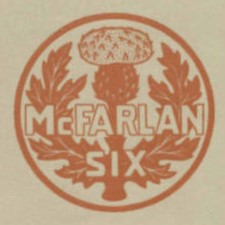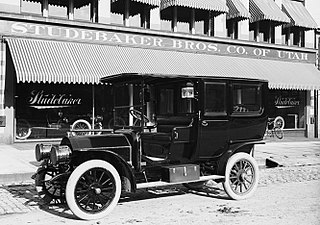
Studebaker was an American wagon and automobile manufacturer based in South Bend, Indiana, with a building at 1600 Broadway, Times Square, Midtown Manhattan, New York City. Founded in 1852 and incorporated in 1868 as the Studebaker Brothers Manufacturing Company, the firm was originally a coachbuilder, manufacturing wagons, buggies, carriages and harnesses.

Coupé de ville — also known as town car or sedanca de ville — is a car body style produced from 1908 to 1939 with an external or open-topped driver's position and an enclosed compartment for passengers. Although the different terms may have once had specific meanings for certain car manufacturers or countries, the terms are often used interchangeably.
The De Vaux was an automobile produced by the De Vaux-Hall Motors Company of Grand Rapids, Michigan, and Oakland, California. It was founded by Norman de Vaux and Elbert J. Hall. The company was incorporated on December 15, 1930. The company sold automobiles under the "DeVaux" brand from April 1931 until February 1932, when the company went into receivership.

A coachbuilder or body-maker is a person or company who manufactures bodies for passenger-carrying vehicles. Coachwork is the body of an automobile, bus, horse-drawn carriage, or railway carriage. The word "coach" was derived from the Hungarian town of Kocs. A vehicle body constructed by a coachbuilder may be called a "coachbuilt body" or "custom body".

Fleetwood Metal Body was an automobile coachbuilder formed on April 1, 1909. The company name was derived from Fleetwood, Pennsylvania, home of the company at the start, and lived on for decades in the form of the Cadillac Fleetwood and various Fleetwood trim lines on Cadillac cars. As of 2022, the remaining original buildings of Fleetwood Metal Body are undergoing restoration and renovation into loft-style apartments.

St. Louis Motor Carriage Company was a manufacturer of automobiles at 1211–13 North Vandeventer Avenue in St. Louis, Missouri, founded by George Preston Dorris and John L. French in 1898, with French taking charge of marketing and Dorris heading engineering and production. St. Louis Motor Carriage was the first of many St. Louis automakers and produced automobiles from 1899 to 1907.

McFarlan was a luxury American automobile manufactured in Connersville, Indiana, from 1909 to 1928, by the McFarlan Carriage Company and the McFarlan Motor Car Company.

The Packard Patrician is an automobile which was built by the Packard Motor Car Company of Detroit, Michigan, from model years 1951 through 1956. During its six years in production, the Patrician was built in Packard's Detroit facilities on East Grand Boulevard. The word "patrician" is Latin for a ruling class in Ancient Rome. It was the last "senior level" Packard until production ended in 1958.

Rollston Company was an American coachbuilder producing luxury automobile bodies during the 1920s and 1930s readily acknowledged to be of the very highest quality.

The Quinby was an American automobile manufactured in 1899 in Newark, New Jersey.

A limousine, or limo for short, is a large, chauffeur-driven luxury vehicle with a partition between the driver compartment and the passenger compartment which can be operated mechanically by hand or by a button electronically. A luxury sedan with a very long wheelbase and driven by a professional driver is called a stretch limousine.

Ben Hur trailer was the nickname of the World War II U.S. Army Trailer, 1-ton payload, 2-wheel, cargo, and the Trailer, 1-ton payload, 2-wheel, water tank, 250 gallon. Specialized variants were also manufactured.

The Rauch & Lang Carriage Company was an American electric automobile manufactured in Cleveland, Ohio, from 1905 to 1920 and Chicopee Falls, Massachusetts, from 1920 to 1932.
Briggs Manufacturing was an American, Detroit-based manufacturer of automobile bodies for Ford Motor Company, Chrysler Corporation and other U.S. and European automobile manufacturers.
Derham Body Company of Philadelphia was a custom coachbuilding company founded by Irish wheelwright Joseph Derham (1865–1928) in 1887 to make carriages. As automobiles became more popular their clientele asked Derham to provide bodies for their cars. It was claimed only New York's Brewster had a similar reputation.

Holbrook Company of Hudson, New York manufactured custom automobile bodies and their leading customer was Packard Motor Company.

The Waterhouse Company of Webster, Massachusetts were coachbuilders making high quality custom bodies for chassis supplied by the major automotive businesses.

Willoughby Company was a custom coachbuilding business in Utica, New York. The Willoughby family had been building carriages in Rome, New York for some generations but set up in Utica when they added town cars and limousines to their products. Though always building custom cars Willoughby also built relatively expensive car bodies in small production runs.
The Walker Body Company, a former carriage manufacturer based in Amesbury, Massachusetts, began manufacturing metal automobile bodies in 1911. It went bankrupt in 1930. The manufacturing site remains as the Walker Body Company Factory.
Biddle and Smart was a manufacturer of carriages and then automobile bodies based in Amesbury, Massachusetts. It started as a successful carriage manufacturer before making the transition to auto body manufacturer in 1905.
















